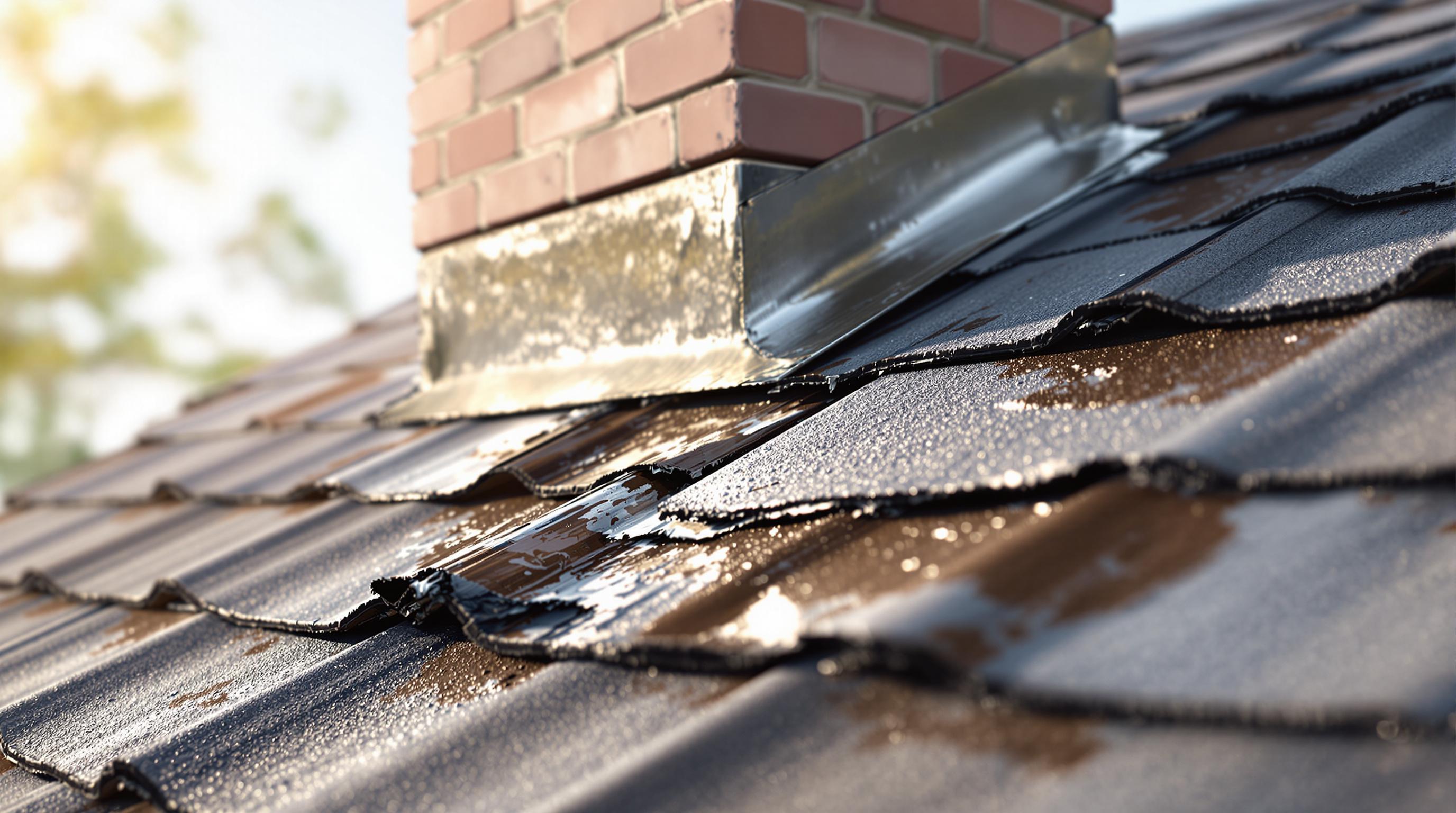Roof damage from storms or accidents can be costly, but filing an insurance claim the right way can save you thousands. Here's a quick guide to help you navigate the process effectively:
- Document the Damage: Take clear photos/videos from multiple angles with timestamps. Keep receipts for temporary repairs.
- Act Quickly: Notify your insurer within 24-48 hours to avoid delays. Most policies have strict deadlines.
- Understand Your Policy: Check your coverage limits, deductibles, and exclusions (e.g., wear and tear or lack of maintenance).
- Get a Professional Inspection: Hire a licensed contractor to assess damage and provide detailed repair estimates.
- Stay Organized: Track all communications, follow up regularly, and keep all claim-related documents in one place.
Following these steps ensures a smoother claims process and maximizes your chances of approval. Let’s break it down further.
How To File An Insurance Claim: For Roof Damage From Wind
1. Document the Damage Properly
Accurate documentation is key to a successful roof insurance claim. It provides the evidence needed to support your claim and helps insurers assess the extent and urgency of the repairs.
Tips for Taking Photos and Videos
When gathering visual evidence, focus on capturing clear and detailed images. Start with wide-angle shots to show the overall damage, then zoom in for close-ups of specific issues. Here’s how to do it effectively:
- Take photos and videos from various angles, both inside and outside, ensuring good lighting to highlight water stains, leaks, or other damage.
- Add timestamps to all visuals for proper recordkeeping.
- Keep the original, unedited files intact for credibility. [4]
Organized and clear evidence makes it easier to demonstrate the full scope of the damage to your insurer.
Temporary Repairs and Proof of Mitigation
After documenting the damage, you might need to make temporary repairs to prevent further issues. This shows your insurance provider that you’re taking steps to protect your property.
To document these efforts:
- Photograph the area before, during, and after the repairs.
- Save receipts for materials and any emergency services used.
- Retain weather reports or emergency service records related to the incident. [5]
"Thorough documentation speeds up claims by clearly showing damage and mitigation steps, reducing delays." [2][4]
For homeowners in Houston facing roof emergencies, the Houston Roofing Directory connects you with certified contractors who can assist with emergency repairs and documentation. These professionals are familiar with local building codes and insurance requirements, offering valuable expertise during this process.
Once you’ve gathered your evidence, acting quickly is essential to keep your claim moving forward without unnecessary delays.
2. Act Quickly to Avoid Delays
Why Timing Matters
Most insurance companies require you to report damage within 30 to 60 days, so acting fast is crucial [4]. Delaying can make the claims process harder and even lead to denied coverage or additional damage going uncovered. Reporting promptly shows responsibility and helps speed up claim approval.
What to Do Right Away
Once you've documented the damage, taking immediate action ensures your claim moves forward without unnecessary delays. Here's how to get started:
-
Contact Your Insurer ASAP
Reach out to your insurance company's claims department right away. Note the date, time, and the name of the representative you speak with for your records. Many insurers now offer online claim submission, which can save time [6]. -
Handle Emergency Repairs
If your roof needs urgent repairs to prevent further damage, don't wait for the insurance adjuster. Hire a qualified roofing contractor to address the issue immediately. Make sure to document the repairs and hold onto receipts for your claim [6][3].
For those in Houston, the Houston Roofing Directory is a great resource to find certified contractors who specialize in emergency repairs and insurance claims. These contractors are familiar with local building codes and can provide the necessary paperwork for your claim.
Keep track of all communications, including dates, names, and important details, to stay organized and ensure accountability. Insurance companies often prioritize claims based on urgency and timing, so reporting damage quickly increases your chances of a faster response and resolution [6][2].
Taking swift action not only helps streamline the claims process but also minimizes potential complications down the line.
sbb-itb-df3c0e6
3. Understand Your Insurance Policy
Knowing the details of your insurance policy helps ensure your claim meets its coverage, limits, and requirements. Without this understanding, you might face delays or even have your claim denied - especially in urgent situations.
What to Look for in Your Policy
Replacement Cost Value (RCV) covers the full cost of replacing damaged property, while Actual Cash Value (ACV) subtracts depreciation, which can leave you paying more out of pocket [3].
Here are the key aspects to review in your policy:
| Component | Description | Why It Matters |
|---|---|---|
| Coverage Limits | Maximum payout amount | Defines how much of the damage is covered |
| Deductibles | Your required payment | Determines your upfront cost |
| Filing Deadlines | Time limits for claims | Missing deadlines can void your claim |
| Documentation | Proof requirements | Ensures you have the right evidence |
Common Exclusions for Roof Damage
Insurance often excludes damage caused by:
- Normal Wear and Tear: Gradual aging and deterioration [2][3]
- Lack of Maintenance: Failing to perform routine upkeep
- Age-Related Issues: Issues with older roofs past their lifespan
"Insurance covers sudden events like hail or fire, not maintenance issues" [2][3]
Regular roof inspections can help you document proper maintenance, potentially avoiding exclusions due to neglect [4]. For weather-related risks, check your policy for special endorsements, especially if you live in areas prone to severe weather. Additional coverage may be necessary for wind or hail damage in these regions [2][3].
Once you fully understand your policy, scheduling a professional roof inspection can help confirm the damage matches covered events and provide the documentation you’ll need for your claim.
4. Get a Professional Roof Inspection
Getting your roof inspected by a professional can significantly strengthen your insurance claim. These inspections provide detailed documentation and expert evaluations that insurance companies value when making decisions.
Why Professional Inspections Matter
A professional inspection can speed up the claims process and help avoid disputes. Here’s how it can benefit your claim:
| Benefit | How It Helps Your Claim |
|---|---|
| Detailed Documentation | Reports with photos and measurements clearly show the damage |
| Expert Assessment | Professionals can spot hidden damage that adjusters might overlook |
| Accurate Estimates | Repair costs are calculated based on current market rates |
Insurance companies often rely on these professional assessments because they offer objective evidence of damage and the repairs needed [1][3]. This thorough documentation ensures the adjuster's evaluation aligns with the actual damage, reducing the chances of disputes [4].
"Professional inspections can provide an objective assessment of the damage, which can help in resolving disputes. Detailed reports from professionals can also provide evidence to support the claim, reducing the likelihood of disputes" [1][3]
Choosing the Right Roofing Contractor
When selecting a contractor, look for someone with proper licensing, insurance, and experience in handling insurance claims. Key qualifications to consider:
- Valid license and insurance
- Experience with insurance claims
- Professional certifications
During the inspection, ask for:
- Photo documentation of the damage
- A written explanation of findings
- Itemized repair estimates
- A timeline for the suggested repairs
Make sure the inspector tailors their documentation to match the requirements of your insurance policy [2][4]. This alignment can make the claims process much smoother.
Once you have the inspection report, you’ll be better prepared to move forward with the claims process and secure approval for the necessary repairs.
5. Manage the Claims Process Effectively
Handling a roof insurance claim can feel overwhelming, but staying organized and keeping communication clear with your insurance provider can make a big difference. A well-structured approach can help you navigate the process more smoothly.
Steps to File Your Claim
Filing an insurance claim involves several key stages. Here's a breakdown of what to do at each step:
| Stage | Actions | Key Details |
|---|---|---|
| Initial Contact | Notify your insurer within 24-48 hours | Acting quickly shows responsibility and urgency. |
| Submit Evidence | Provide photos, videos, and inspection reports | Ensure all documentation is thorough and accurate. |
| Adjuster Meeting | Schedule within 1-2 weeks | Try to attend with a contractor for added support. |
| Repair Estimates | Get 2-3 detailed quotes | Make sure the estimates align with your policy coverage. |
| Follow-up | Check the claim status regularly | Contact the insurer every 7-10 days for updates. |
When filing your claim, be as detailed as possible about the damage and when it occurred. Most insurance companies have a one-year deadline for claims, but submitting yours within 30-60 days can improve your chances of approval [4].
Once the claim is filed, staying in touch with your insurer is critical to avoid delays and keep things on track.
Tips for Communicating with Your Insurer
Clear communication with your insurance company is essential. Keep all claim-related information in one place, like a dedicated file or folder, to track progress and ensure nothing gets lost.
Here are some key steps for effective communication:
- Document everything: Record dates, names, and summaries of all discussions. Follow up with written confirmations of important points.
- Stay professional: Be polite and calm, even if disagreements arise.
- Handle disputes carefully: If there’s a conflict, ask for a re-inspection or consult a public adjuster for a second opinion [4].
Patience and persistence are your best tools. While many claims are resolved in a few weeks, more complex ones, especially those involving major damage, can take longer [3][4]. Regularly following up and keeping your documentation organized will help ensure the process moves forward as efficiently as possible.
Conclusion: Key Points for Filing Roof Insurance Claims
Filing a roof insurance claim successfully involves acting fast, keeping detailed records, and staying in constant communication with your insurer. Reach out to your insurance company within 24-48 hours to avoid delays and ensure your claim is processed on time. Detailed documentation, such as professional inspection reports, can significantly strengthen your case and assist adjusters in their evaluations.
When hiring contractors, choose those with the right credentials and experience in handling insurance claims. The Houston Roofing Directory is a helpful resource for finding licensed contractors who specialize in this area.
Key factors for navigating the claims process include:
- Acting quickly to report damage
- Keeping thorough records and obtaining professional assessments
- Knowing the details of your policy
- Maintaining clear communication with your insurer
- Following up regularly every 7-10 days [4]


